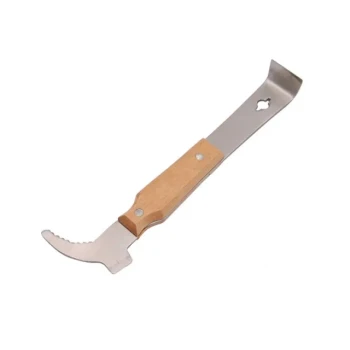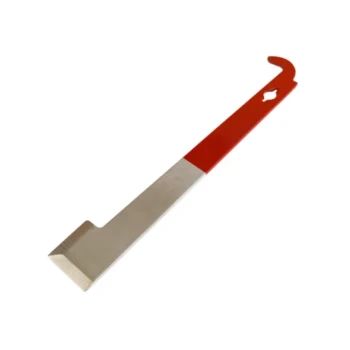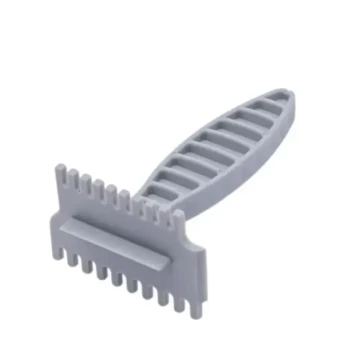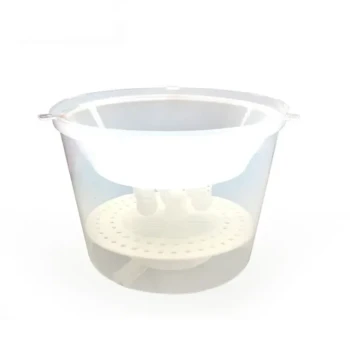A bee vacuum is an essential tool for safely and efficiently collecting bee colonies from locations where other methods are impractical or impossible. It allows a beekeeper to gently suction bees from wall cavities, chimneys, or high tree branches and contain them in a specially designed, ventilated chamber for transport to a new hive.
While a bee vacuum makes difficult removals possible, its true value lies in using precisely controlled, low-power suction to ensure the colony's survival. The goal is not just removal, but successful and humane relocation.
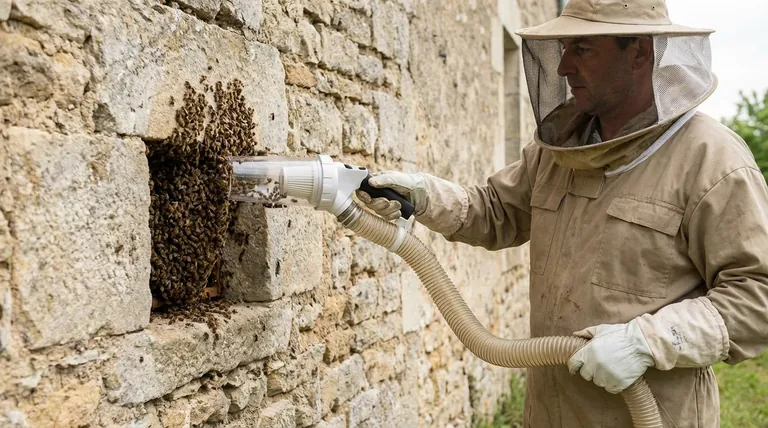
When a Bee Vacuum is the Right Tool
A bee vacuum is a specialized piece of equipment, not a first resort for every situation. Its utility shines in specific, challenging scenarios.
Accessing Difficult Locations
The primary use for a bee vacuum is removing established colonies or swarms from structurally complex and hard-to-reach places. This includes colonies inside walls, soffits, chimneys, and water meter boxes.
Maximizing Speed and Efficiency
For large, dispersed colonies, a bee vacuum can be significantly faster than attempting to brush or scoop bees into a container. This efficiency reduces stress on both the bees and the beekeeper.
Minimizing Direct Contact
The vacuum allows for the removal of an entire colony with minimal direct handling. This is a significant safety advantage, reducing the risk of stings for the operator, especially when dealing with a defensive colony.
How a Bee Vacuum Works to Protect Bees
A common misconception is that a bee vacuum is simply a modified shop-vac. In reality, a well-designed bee vacuum is engineered specifically for the gentle handling of live insects.
The Principle of Low-Pressure Suction
The most critical feature is its low and often adjustable suction power. The airflow is calibrated to be just strong enough to lift and carry a bee through the hose without causing injury from high-speed impacts.
The Importance of the Collection Chamber
Bees are not sucked into a bag of dust and debris. They are deposited into a large, dedicated box or "nuc" that has ample ventilation. This space prevents bees from being crushed and allows air to circulate, preventing them from overheating.
The Role of the Hose
The hose is typically wide and has a smooth interior to minimize turbulence and reduce the number of bees that collide with the sides. This gentle journey is key to their survival.
Understanding the Trade-offs and Risks
While effective, using a bee vacuum is not without risk. Operator error or poor equipment can be detrimental to the colony.
The Risk of Excessive Suction
This is the single greatest danger. Using too much suction power will cause significant trauma and kill many bees as they are slammed into the collection chamber or the end of the hose.
The Danger of Poor Ventilation
Bees generate a substantial amount of heat, especially when agitated. A collection chamber with inadequate ventilation will quickly become an oven, leading to a high mortality rate. The bees must be transferred to their new hive as soon as possible.
Inevitable Stress and Minor Casualties
Even when used correctly, the process is stressful for the bees. It is normal for a small percentage of the colony to perish during the vacuuming and relocation process. The goal is to keep this number as low as possible through proper technique.
Making the Right Choice for Your Goal
Using a bee vacuum requires a clear understanding of your objective and a commitment to the bees' welfare.
- If your primary focus is humane relocation: Prioritize a vacuum with adjustable suction control and a large, well-ventilated collection box to maximize the colony's survival rate.
- If your primary focus is removing a colony from an inaccessible structure: The bee vacuum is often the only viable tool, but its proper use is paramount to avoid unnecessarily harming the colony.
By understanding its principles and respecting its risks, the bee vacuum becomes an invaluable asset for responsible bee removal and management.
Summary Table:
| Key Feature | Purpose & Benefit |
|---|---|
| Low-Pressure Suction | Gently lifts bees without causing injury, ensuring colony survival. |
| Ventilated Collection Chamber | Prevents overheating and crushing, providing a safe space for bees during transport. |
| Access to Difficult Locations | Enables removal from wall cavities, chimneys, and high tree branches. |
| Minimized Direct Contact | Reduces sting risk for the operator, especially with defensive colonies. |
Ready to perform safe and humane bee relocations?
As a trusted wholesale supplier to commercial apiaries and beekeeping equipment distributors, HONESTBEE provides the professional-grade bee vacuums and equipment you need. Our products are designed with the precise, low-power suction and proper ventilation required to maximize colony survival rates during difficult removals.
Let us equip your operation for success. Contact our team today to discuss your specific needs and discover how our wholesale-focused solutions can enhance your beekeeping services.
Visual Guide
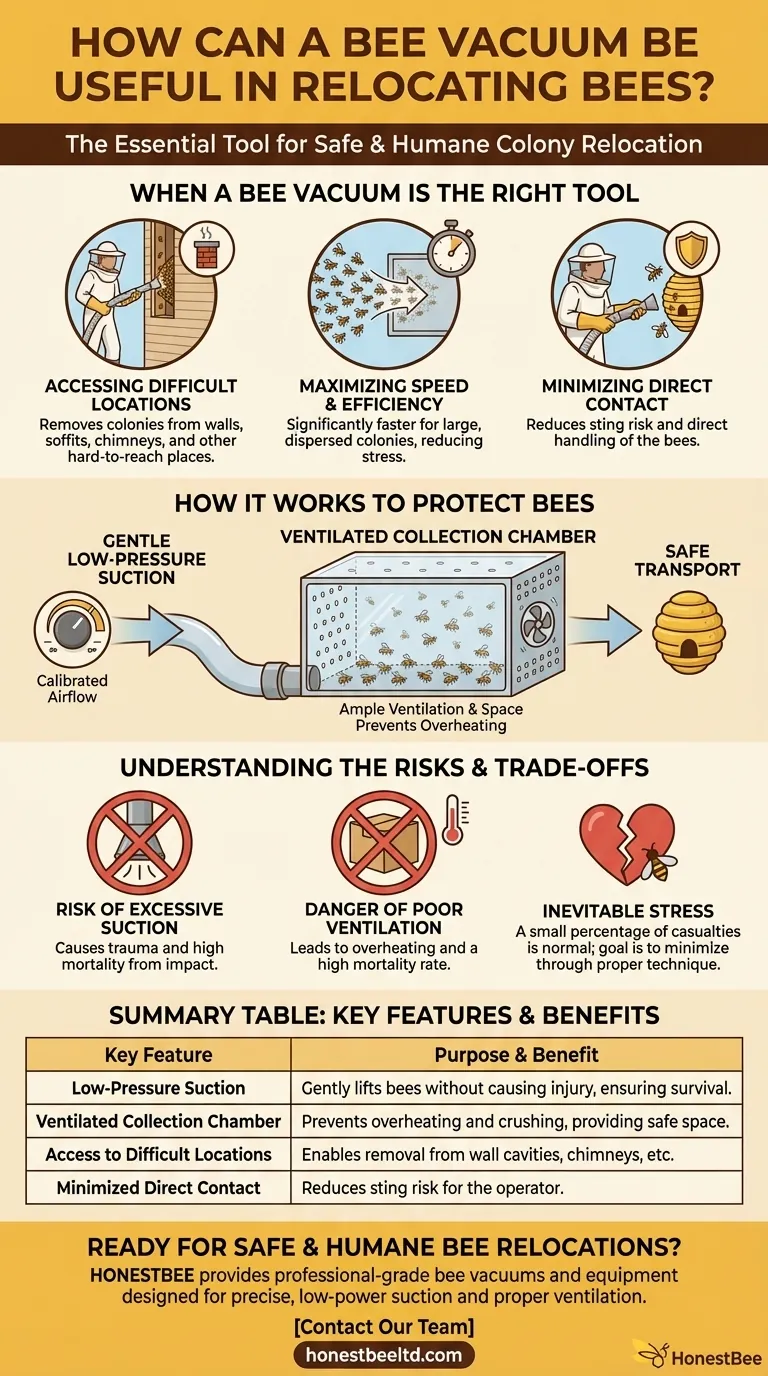
Related Products
- HONESTBEE Professional Long Handled Hive Tool with Precision Cutting Blade
- HONESTBEE Advanced Ergonomic Stainless Steel Hive Tool for Beekeeping
- Professional Dual-End Stainless Steel Hive Tool for Beekeeping
- HONESTBEE Professional Multi-Functional Hive Tool with Ergonomic Wood Handle
- Professional 3-Bar Frame Grip with Integrated Hive Tool
People Also Ask
- What tools are used for cleaning frames? A Beekeeper's Simple 4-Tool Guide
- How can a hive tool be used to remove propolis and burr comb? Master Hive Maintenance for a Healthy Colony
- What are some common uses of a hive tool? Essential Multi-Purpose Tool for Every Beekeeper
- How should beekeepers handle bees when using a hive tool? Master Calm, Deliberate Techniques
- Why do hive tools have a hole? Unlock the Secret to Efficient Beekeeping



